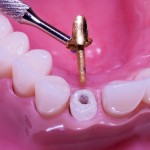
Endodontically treated teeth (ETT) are considered to be more brittle and subject to fracture. Posts are frequently used to restore ETT and use of the appropriate post material is considered important to a successful restoration. The aim of this review of in-vitro studies was to compare the fracture load of ETT restored with cast of fibre posts in a loading test.
The Medline, Cochrane Controlled Trials Register, China National Knowledge Infrastructure and China Biology Medicine databases were searched for articles in English or Chinese. Randomised controlled trials conducted on single rooted, caries-free, freshly extracted teeth that had been kept moist before use and had had standardised root canal therapy performed were included.
- 13 Studies were included (8 in English and 5 studies in Chinese). Human premolars were used in 6 studies, central incisors in 5 studies, and canines in 3 articles. The majority of studies (9) used Ni-Cr alloy as the cast material. Glass fibre posts were used in 11 studies, carbon fibre posts in 2 studies, and quartz fibre posts in 1 study.
- The standardised mean difference of the combined data was 0.64 (95% confidence interval, 0.08–1.20; P < .001), indicating that the cast post group displayed significantly higher fracture resistance than the fibre post group.
The authors concluded
On the basis of the current best available evidence, we concluded that cast posts had higher fracture resistance than fibre posts
Comment
As noted by the authors it is important to note that these results were based on in-vitro trials and although they may provide some indication of performance in the clinical situation this cannot be guaranteed. The authors also discussed the variation in the testing methods used in the studies, which may have influenced their findings. The 2008 Cochrane review by Bolla et al looked at the effectiveness of different post and core systems for the restoration of endodontically-treated teeth and concluded.
Our systematic review could not specify which type of post and core system should be used when two or three dentine walls remain. More RCTs are needed to confirm whether fibre-reinforced post and core systems are superior and to clarify the influence of the remaining tooth structure on the treatment outcome of the different post and core systems available. Well-defined inclusion criteria focusing on the number of dentine walls (two or three) should be used.
Links
Zhou L, Wang Q. Comparison of Fracture Resistance between Cast Posts and Fiber Posts: A Meta-analysis of Literature. J Endod. 2013 Jan;39(1):11-5. doi: 10.1016/j.joen.2012.09.026. Epub 2012 Oct 24. PubMed PMID: 23228250.
Bolla M, Muller-Bolla M, Borg C, Lupi-Pegurier L, Laplanche O, Leforestier E. Root canal posts for the restoration of root filled teeth. Cochrane Database of Systematic Reviews 2007, Issue 1. Art. No.: CD004623. DOI: 10.1002/14651858.CD004623.pub2.

[…] Review of in-vitro studies shows greater fracture resistance for cast posts […]